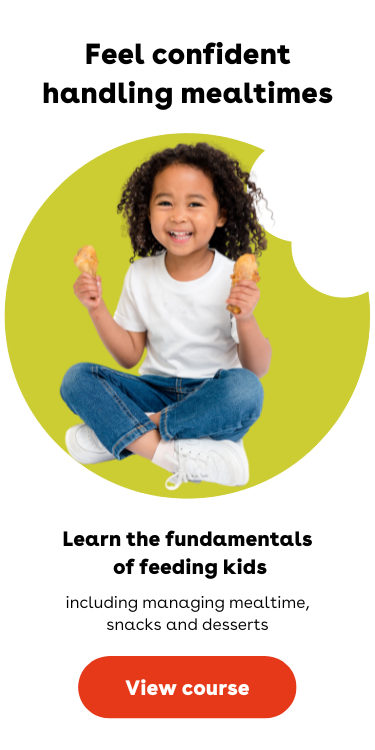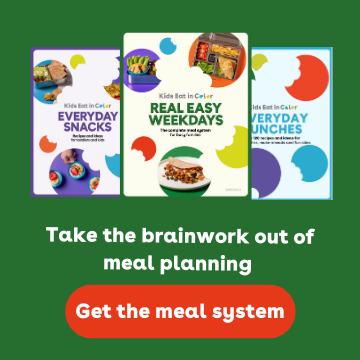Inside: Child not eating? Learn 5 reasons your child may not be eating and what you can do about them to make sure that they are getting what they need to thrive.
“Is he suddenly picky or is this just a phase?” She asked me nervously. Her child seemed to be eating really well as a toddler, but then she realized one day when he was 3, “my child is not eating.” He was rejecting foods he previously liked. Worry was starting to take over for her. What should she do? Would it pass on it’s own?
I see this a lot – not only with other families, but in my own as well. In fact, I was lucky enough to be one of the parents who got to ask “why is my toddler not eating?” Feeding kids is tricky. Any time your child’s eating changes, it’s time to stop and think.
There are 5 reasons why your once adventurous eater may change their eating habits.
1. Your Child’s Not Eating Because of Pressure
Pressure at mealtime is the death of good eating habits for many kids. What do I mean by pressure? Pressure looks different in many families, but here are a few ways it comes out during meals:
- “Finish everything on your plate before you get down.”
- “You have to eat all of your spaghetti before you get any strawberries.”
- “3 more bites before you get down.”
- “You have to take a bite of everything on your plate.”
- “You can’t have more bread unless you eat all your other food first.”
- “If you don’t eat this now, I will serve it to you over and over until you eat it.”
Basically, it’s you and me, the parents, trying to force our child to eat something when they do not want to eat something. I’m not sure about you, but if someone tries to force me to eat something, I often push back. I don’t want to eat when someone is forcing me to eat. It’s the same for kids.
But wait. I’m the parent? I know what my kid needs and I should be able to make them eat what they need! I hear you and feel you.
Here’s the thing, us parents actually don’t know how our child feels while they are eating. They may not have the words to describe what they are feeling inside. Many kids, especially young ones, are very good at knowing when they are hungry or full. Kids also know if they feel grossed out, scared, or stressed. All those things may affect their appetite. Pressure messes that up.
Plus, we know that putting pressure on kids to eat is not associated with ending picky eating. In fact, parents who use a low pressure, high structure approach to feeding kids, often have kids who can learn to overcome picky eating.
So what are you supposed to do instead?
Let your child decide whether they will eat at each meal and snack, and let them decide how much they will eat.
That means you will drop the pressure and allow them to choose to eat or not. You will also allow them to decide how much they will eat. If they only want to eat one bite for this meal, it’s fine. They have another meal or snack coming in the next few hours.
In my BetterBites program families often say ending pressure is the scariest, but the most rewarding thing that they do in the program.
So is it a free-for-all where your kid can eat whatever they want, whenever they want?
Nope. Keep reading.
2. Lack of a Meal and Snack Schedule Can Make Your Child Not Eat
We already know it’s really important to allow kids to choose how much they will eat and whether they will eat at all. That doesn’t mean they get to call the shots though. In fact, they are just in charge of their own bodies.
Us parents are in charge of everything else. We’re in charge of making a meal and snack schedule and deciding where kids can eat food. We’re also in charge of what food is served at meals.
When a child doesn’t have a meal and snack schedule, they often won’t be hungry at the right time. In fact, “grazing” or kids eating whenever they want, can make many kids stop eating at mealtime. If they’ve already had 8 snacks between 7am and 4pm, they probably won’t be hungry for dinner at 5pm.
Instead, it’s a best practice to have certain times that you serve meals and snacks – just like they do at school, preschool, or daycare. Kids aren’t allowed to eat whenever they want, because you need them to be hungry for meals and planned snacks. That’s what keeps them eating healthfully.
What Does a Meal Schedule Look Like?
For age preschool and up, have a schedule that feeds them every 2.5 – 4 hours. This will look different depending on how much your child sleeps and your family’s schedule.
For most families, 3 meals and 0-2 snacks is fine. Some families (mine included), find they need 3 meals and 3 snacks because of their child’s food needs. I don’t recommend more than 3 meals and 3 snacks.
Once you make your meal and snack schedule, stick to it. Your child can decide whether to eat and how much at each meal and snack. Only water in between though.
Is it Okay to Make Exceptions?
Of course! This doesn’t mean you can never make an exception. There are always exceptions with kids (looking at you with the hangry toddler attacking the new baby sibling). Try to keep exceptions to a minimum though, because you need your child to be hungry for meals and snacks.
The Parent’s Job:
And speaking of meals and snacks, as the parent, it’s also your job to decide where meals are served. Serving them at the table is a great idea and an easier way to minimize distractions, like watching TV during meals (which can increase picky eating dramatically).
Also, it’s your job to decide what food is served during meals. It’s not our kids’ job to plan out their own nutritious diet. They don’t know what they are doing – and we all know if we left it to them, we’d be eating a lot of mac and cheese, right? That’s why it’s your job as the parent to serve food to your child.
Your Child’s Job:
You serve the meals and leave it up to them to decide whether they will eat it and how much. One important thing though. Be kind. Always serve at least one food at meals and snacks that you know your child does like.
Related: End Whining With This Simple Snack Hack
3. Pickiness is Making Your Child Not Eat
Maybe your child actually is hungry though, they are just not eating. That feels a little bit scarier. They are asking for food and you know they are hungry, but they are just not eating what is on the table. Your child may be a “selective eater.” There are 3 reasons why a child may be a selective or picky eater.
First, they may be afraid of new foods.
This is called “neophobia.” This is typical of young kids, and usually starts showing up between ages 12 months and 5 years old.
This means they are literally afraid. Like, scared. They aren’t faking this fear. Some kids have a lot of fear and some kids just have a little fear. If they are really scared of whatever is on their plate, it’s going to be difficult for them to eat it. They may sit with extreme hunger if they are extremely afraid.
Second, they may have a picky eating disorder.
Avoidant Restrictive Feeding Intake Disorder (ARFID) is an eating disorder that results in children not eating enough to meet their nutritional needs. They may lose weight, not eat enough to grow, or eat so few foods (like 5), that they cannot possibly meet their nutrient needs. If your child is extremely picky and your doctor is concerned about their growth, it may be a good time to talk to a pediatric dietitian about ARFID.
Third, your child is picky because their sensory system is overwhelmed or underwhelmed by foods.
They may be completely overwhelmed by the smell of foods. They may be completely grossed out by how a food feels. Or they may only like the way crunchy foods feel in their mouth.
Whether your child is afraid of new foods, has ARFID, or is picky because of their sensory system, one thing that helps is playing with food. When children play with food, their sensory system gets used to it, they get over their fear of new foods (slowly), and they learn to eat new foods gradually over time.
Does any food play work? Nope. Throwing food never helps kids learn to like new foods, although they may think it’s fun (major mom eye roll). Instead, you need to find activities that are developmentally appropriate for your child and slowly help them adjust their sensory system to new foods. Here is the food play guide that I use in my therapeutic picky eater program.
4. Your Child’s Overwhelmed with Big Portions and Will Not Eat
Some kids are just overwhelmed with big portions of food. As parents, it’s easy to think our kids need to eat much more than they do. When your child sees all that food, they are like, “Nah, I can’t tackle that. I’ll just sit here.”
How much do kids need to eat? It all depends on the kid. People have different amounts of energy that they need no matter what their age. Your child may need a very small amount of food to thrive.
I recommend starting with very small portions and then letting them have more as many times as they want.
What is small?
Well, next time you serve a meal to your child, note how much you put on the plate. Next time you serve food after that, serve ¼ of that amount. Yes, that’s right, one quarter. They can ask for more 3, 5 or 7 more times, and each time give them a small portion.
This is also a great way to reduce food waste!
If you know your child doesn’t like the food, you can choose whether you want to put the food on their plate or not. If you do, put an “exposure portion” on their plate – the size of half of your pinky nail. Then again, you don’t have to worry about food waste.
5. Your Child Would Rather Be Playing and Not Eating
Got a wiggly child? I have 2, so I hear you. Some kids would just rather do anything at all than sit and eat. That’s okay, as long as you have the right expectations. It’s still important that they sit at the table for an age-appropriate amount of time.
When my kids were 1-3, that meant about 12 minutes (and we worked up to that!) When my kids were 3-5, that meant 15 minutes.
Another thing you can do is bring eating fun to the table. Fun utensils can be a great way to make them interested at meal time. Of course you never have to use fun utensils, but I’ve seen my situation go from “child not eat” to “child eating”, just because they had a forklift fork!
Related: Top 11 Eating Utensils for Kids










Inside: Child not eating? Learn 5 reasons your child may not be eating and what you can do about them to make sure that they are getting what they need to thrive.
“Is he suddenly picky or is this just a phase?” She asked me nervously. Her child seemed to be eating really well as a toddler, but then she realized one day when he was 3, “my child is not eating.” He was rejecting foods he previously liked. Worry was starting to take over for her. What should she do? Would it pass on it’s own?
I see this a lot – not only with other families, but in my own as well. In fact, I was lucky enough to be one of the parents who got to ask “why is my toddler not eating?” Feeding kids is tricky. Any time your child’s eating changes, it’s time to stop and think.
There are 5 reasons why your once adventurous eater may change their eating habits.
1. Your Child’s Not Eating Because of Pressure
Pressure at mealtime is the death of good eating habits for many kids. What do I mean by pressure? Pressure looks different in many families, but here are a few ways it comes out during meals:
Basically, it’s you and me, the parents, trying to force our child to eat something when they do not want to eat something. I’m not sure about you, but if someone tries to force me to eat something, I often push back. I don’t want to eat when someone is forcing me to eat. It’s the same for kids.
But wait. I’m the parent? I know what my kid needs and I should be able to make them eat what they need! I hear you and feel you.
Here’s the thing, us parents actually don’t know how our child feels while they are eating. They may not have the words to describe what they are feeling inside. Many kids, especially young ones, are very good at knowing when they are hungry or full. Kids also know if they feel grossed out, scared, or stressed. All those things may affect their appetite. Pressure messes that up.
Plus, we know that putting pressure on kids to eat is not associated with ending picky eating. In fact, parents who use a low pressure, high structure approach to feeding kids, often have kids who can learn to overcome picky eating.
So what are you supposed to do instead?
Let your child decide whether they will eat at each meal and snack, and let them decide how much they will eat.
That means you will drop the pressure and allow them to choose to eat or not. You will also allow them to decide how much they will eat. If they only want to eat one bite for this meal, it’s fine. They have another meal or snack coming in the next few hours.
In my BetterBites program families often say ending pressure is the scariest, but the most rewarding thing that they do in the program.
So is it a free-for-all where your kid can eat whatever they want, whenever they want?
Nope. Keep reading.
2. Lack of a Meal and Snack Schedule Can Make Your Child Not Eat
We already know it’s really important to allow kids to choose how much they will eat and whether they will eat at all. That doesn’t mean they get to call the shots though. In fact, they are just in charge of their own bodies.
Us parents are in charge of everything else. We’re in charge of making a meal and snack schedule and deciding where kids can eat food. We’re also in charge of what food is served at meals.
When a child doesn’t have a meal and snack schedule, they often won’t be hungry at the right time. In fact, “grazing” or kids eating whenever they want, can make many kids stop eating at mealtime. If they’ve already had 8 snacks between 7am and 4pm, they probably won’t be hungry for dinner at 5pm.
Instead, it’s a best practice to have certain times that you serve meals and snacks – just like they do at school, preschool, or daycare. Kids aren’t allowed to eat whenever they want, because you need them to be hungry for meals and planned snacks. That’s what keeps them eating healthfully.
What Does a Meal Schedule Look Like?
For age preschool and up, have a schedule that feeds them every 2.5 – 4 hours. This will look different depending on how much your child sleeps and your family’s schedule.
For most families, 3 meals and 0-2 snacks is fine. Some families (mine included), find they need 3 meals and 3 snacks because of their child’s food needs. I don’t recommend more than 3 meals and 3 snacks.
Once you make your meal and snack schedule, stick to it. Your child can decide whether to eat and how much at each meal and snack. Only water in between though.
Is it Okay to Make Exceptions?
Of course! This doesn’t mean you can never make an exception. There are always exceptions with kids (looking at you with the hangry toddler attacking the new baby sibling). Try to keep exceptions to a minimum though, because you need your child to be hungry for meals and snacks.
The Parent’s Job:
And speaking of meals and snacks, as the parent, it’s also your job to decide where meals are served. Serving them at the table is a great idea and an easier way to minimize distractions, like watching TV during meals (which can increase picky eating dramatically).
Also, it’s your job to decide what food is served during meals. It’s not our kids’ job to plan out their own nutritious diet. They don’t know what they are doing – and we all know if we left it to them, we’d be eating a lot of mac and cheese, right? That’s why it’s your job as the parent to serve food to your child.
Your Child’s Job:
You serve the meals and leave it up to them to decide whether they will eat it and how much. One important thing though. Be kind. Always serve at least one food at meals and snacks that you know your child does like.
Related: End Whining With This Simple Snack Hack
3. Pickiness is Making Your Child Not Eat
Maybe your child actually is hungry though, they are just not eating. That feels a little bit scarier. They are asking for food and you know they are hungry, but they are just not eating what is on the table. Your child may be a “selective eater.” There are 3 reasons why a child may be a selective or picky eater.
First, they may be afraid of new foods.
This is called “neophobia.” This is typical of young kids, and usually starts showing up between ages 12 months and 5 years old.
This means they are literally afraid. Like, scared. They aren’t faking this fear. Some kids have a lot of fear and some kids just have a little fear. If they are really scared of whatever is on their plate, it’s going to be difficult for them to eat it. They may sit with extreme hunger if they are extremely afraid.
Second, they may have a picky eating disorder.
Avoidant Restrictive Feeding Intake Disorder (ARFID) is an eating disorder that results in children not eating enough to meet their nutritional needs. They may lose weight, not eat enough to grow, or eat so few foods (like 5), that they cannot possibly meet their nutrient needs. If your child is extremely picky and your doctor is concerned about their growth, it may be a good time to talk to a pediatric dietitian about ARFID.
Third, your child is picky because their sensory system is overwhelmed or underwhelmed by foods.
They may be completely overwhelmed by the smell of foods. They may be completely grossed out by how a food feels. Or they may only like the way crunchy foods feel in their mouth.
Whether your child is afraid of new foods, has ARFID, or is picky because of their sensory system, one thing that helps is playing with food. When children play with food, their sensory system gets used to it, they get over their fear of new foods (slowly), and they learn to eat new foods gradually over time.
Does any food play work? Nope. Throwing food never helps kids learn to like new foods, although they may think it’s fun (major mom eye roll). Instead, you need to find activities that are developmentally appropriate for your child and slowly help them adjust their sensory system to new foods. Here is the food play guide that I use in my therapeutic picky eater program.
4. Your Child’s Overwhelmed with Big Portions and Will Not Eat
Some kids are just overwhelmed with big portions of food. As parents, it’s easy to think our kids need to eat much more than they do. When your child sees all that food, they are like, “Nah, I can’t tackle that. I’ll just sit here.”
How much do kids need to eat? It all depends on the kid. People have different amounts of energy that they need no matter what their age. Your child may need a very small amount of food to thrive.
I recommend starting with very small portions and then letting them have more as many times as they want.
What is small?
Well, next time you serve a meal to your child, note how much you put on the plate. Next time you serve food after that, serve ¼ of that amount. Yes, that’s right, one quarter. They can ask for more 3, 5 or 7 more times, and each time give them a small portion.
This is also a great way to reduce food waste!
If you know your child doesn’t like the food, you can choose whether you want to put the food on their plate or not. If you do, put an “exposure portion” on their plate – the size of half of your pinky nail. Then again, you don’t have to worry about food waste.
5. Your Child Would Rather Be Playing and Not Eating
Got a wiggly child? I have 2, so I hear you. Some kids would just rather do anything at all than sit and eat. That’s okay, as long as you have the right expectations. It’s still important that they sit at the table for an age-appropriate amount of time.
When my kids were 1-3, that meant about 12 minutes (and we worked up to that!) When my kids were 3-5, that meant 15 minutes.
Another thing you can do is bring eating fun to the table. Fun utensils can be a great way to make them interested at meal time. Of course you never have to use fun utensils, but I’ve seen my situation go from “child not eat” to “child eating”, just because they had a forklift fork!
Related: Top 11 Eating Utensils for Kids